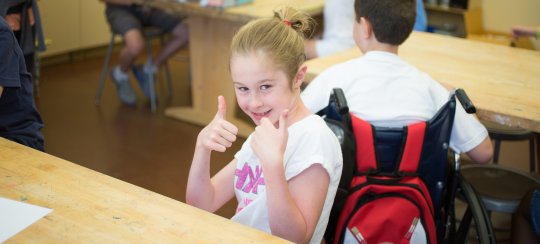By the end of this lesson students will be able to write a free-verse poem, carefully selecting words and phrases to communicate feelings and images for readers.
“I can write a free-verse poem, carefully selecting words and phrases to communicate feelings and images for my readers.”
LESSON OVERVIEW
| Steps |
Pacing: 60 Minutes |
|
|
45 Minutes |
|
|
15 Minutes |
Standards Alignment
Reading Standards (Literature)
RL 3.5: Refer to parts of stories, dramas, and poems when writing or speaking about a text, using terms such as chapter, scene, and stanza; describe how each successive part builds on earlier sections.
RL 4.5: Explain major differences between poems, drama, and prose, and refer to the structural elements of poems (e.g., verse, rhythm, meter) and drama (e.g., casts of characters, settings, descriptions, dialogue, stage directions) when writing or speaking about a text.
RL 5.5: Explain how a series of chapters, scenes, or stanzas fits together to provide the overall structure of a particular story, drama, or poem.
Writing & Language Standards
W 3.4: With guidance and support from adults, produce writing in which the development and organization are appropriate to task and purpose.
W 3.5: With guidance and support from peers and adults, develop and strengthen writing as needed by planning, revising, and editing.
W 4.4: Produce clear and coherent writing in which the development and organization are appropriate to task, purpose, and audience.
W 4.5: With guidance and support from peers and adults, develop and strengthen writing as needed by planning, revising, and editing.
W 5.4: Produce clear and coherent writing in which the development and organization are appropriate to task, purpose, and audience.
W 5.5: With guidance and support from peers and adults, develop and strengthen writing as needed by planning, revising, editing, rewriting, or trying a new approach.
Speaking & Listening
SL 3.1a: Come to discussions prepared, having read or studied required material; explicitly draw on that preparation and other information known about the topic to explore ideas under discussion.
SL 3.1b: Follow agreed-upon rules for discussions (e.g., gaining the floor in respectful ways, listening to others with care, speaking one at a time about the topics and texts under discussion).
SL 3.1c: Ask questions to check understanding of information presented, stay on topic, and link their comments to the remarks of others.
SL 3.1d: Explain their own ideas and understanding in light of the discussion.
SL 3.6: Speak in complete sentences when appropriate to task and situation in order to provide requested detail or clarification.
SL 4.1a: Come to discussions prepared, having read or studied required material; explicitly draw on that preparation and other information known about the topic to explore ideas under discussion.
SL 4.1b: Follow agreed-upon rules for discussions and carry out assigned roles.
SL 4.1c: Pose and respond to specific questions to clarify or follow up on information, and make comments that contribute to the discussion and link to the remarks of others.
SL 4.1d: Review the key ideas expressed and explain their own ideas and understanding in light of the discussion.
SL 4.6: Differentiate between contexts that call for formal English (e.g., presenting ideas) and situations where informal discourse is appropriate (e.g., small-group discussion); use formal English when appropriate to task and situation.
SL 5.1a: Come to discussions prepared, having read or studied required material; explicitly draw on that preparation and other information known about the topic to explore ideas under discussion.
SL 5.1b: Follow agreed-upon rules for discussions and carry out assigned roles.
SL 5.1c: Pose and respond to specific questions by making comments that contribute to the discussion and elaborate on the remarks of others.
SL 5.1d: Review the key ideas expressed and draw conclusions in light of information and knowledge gained from the discussions.
SL 5.6: Adapt speech to a variety of contexts and tasks, using formal English when appropriate to task and situation.
Reading Standards (Literature)
RL 3.4: Determine the meaning of words and phrases as they are used in a text, distinguishing literal from nonliteral language.
RL 4.4: By the end of the year, read and comprehend literature, including stories, dramas, and poetry, in the grades 4–5 text complexity band proficiently, with scaffolding as needed at the high end of the range.
RL 5.4: Determine the meaning of words and phrases as they are used in a text, including figurative language such as metaphors and similes.
Writing & Language Standards
L 3.1: Demonstrate command of the conventions of standard English grammar and usage when writing or speaking.
L 3.2: Demonstrate command of the conventions of standard English capitalization, punctuation, and spelling when writing.
L 4.1: Demonstrate command of the conventions of standard English grammar and usage when writing or speaking.
L 4.2: Demonstrate command of the conventions of standard English capitalization, punctuation, and spelling when writing.
L 5.1: Demonstrate command of the conventions of standard English grammar and usage when writing or speaking.
L 5.2: Demonstrate command of the conventions of standard English capitalization, punctuation, and spelling when writing.
Teaching Resources
-Words in Motion Wall Chart (Created in Class)
-Laptop or Tablet
-Speakers (Optional)
Unit 5 includes the following Life & Learning Skills:
-Reflective thinking
-Creative problem-solving
-Critical and analytic thinking
-Collaboration Communication
 Differentiation Options
Differentiation Options
Differentiation Options will appear throughout the unit to suggest ways to scaffold or challenge student learning. Use the number of helping hands to select the level of differentiation that best supports student learning.


 Highest level of scaffolding. Select this option if students are learning strategies for the first time, if the text is challenging for them, or if students require more guidance during activities. Part 1 lessons are written for the highest level of scaffolding.
Highest level of scaffolding. Select this option if students are learning strategies for the first time, if the text is challenging for them, or if students require more guidance during activities. Part 1 lessons are written for the highest level of scaffolding.

 Moderate scaffolding. Select this option if students require some support comprehending the text or navigating the activity.
Moderate scaffolding. Select this option if students require some support comprehending the text or navigating the activity.

Least amount of scaffolding/Extending the instruction. Select this option if students are ready to work more independently, move more quickly through the material, or are ready for additional challenge.
 Leveraging Moments
Leveraging Moments
Key instructional steps where the arts are used to leverage literacy-learning (and vice versa) are marked with  . Smaller leveraging moments also occur throughout the lessons.
. Smaller leveraging moments also occur throughout the lessons.
Process: Give an overview of the lesson objective, which is to write first drafts of poems.
Suggested Dialogue
"Today you will write your poems. To start, we will review the poetry brainstorm we did in our last lesson. Then you will work on your poems."
"By the end of today’s lesson, you will be able to say, 'I can write a free-verse poem, carefully selecting words and phrases to communicate feelings and images for my readers'.”
Process: Lead the students in the BrainDance of Words #4. The audio track for BrainDance of Words #4 (Unit 5, Track 4) has verbal cues and musical accompaniment for the BrainDance. If desired, instead of using the audio track, use the verbal cues below to guide students through the BrainDance. This can be facilitated as a generic BrainDance without descriptive words, with descriptive words, with or without music.
Suggested Dialogue
"We’ll start by warming up our bodies and brains with the BrainDance to prepare us to write our own poems and help us recall some of the words we have explored in the unit.
Breath: Breathe quietly.
Tactile: Bouncily tap your head, your arms, your fronts, your backs, your legs, and your feet.
Core-distal: Expand your body into an enormous shape and contract into a miniscule shape.
Head-tail: Ripple your body forwards and backwards and from side to side.
Upper half: Freeze the lower half of your body. With the top half of your body, move suddenly.
Lower half: Freeze the top half of your body. With the lower half of your body, move gently.
Body-half right: Freeze the left side of your body. With the right side, move playfully.
Body-half left: Freeze the right side of your body. With the left side, move nervously.
Eye-tracking: Follow your right thumb with your eyes. Move it angrily from side to side. Follow your left thumb with your eyes. Move it unhurriedly from side to side.
Cross-lateral: Purposefully reach your arms across the front of your body on different levels.
Vestibular: Aggressively spin and then freeze in a hopeful shape.
Breath: Breathe quietly."
Process: Students write first drafts of their free-verse poems. See menu below,
Differentations Options: Drafting Free-Verse Poems for ways to scaffold the activity. Model writing a free-verse poem if appropriate for students. See the Suggested Dialogue below for a sample modeling script. Then, guide students to review their brainstorm on
pages 20-21 in their A4L Notebooks and then write the first drafts of their poems on
pages 22-23. See the menu below
Prompts to Guide Free-Verse Poem Writing for tips to support students.
If desired, set a poem length that is appropriate for students. For example, between five and 20 lines. If students finish quickly, have them brainstorm and write another poem or share their poem draft with a partner.
 Differentiation Options: Drafting Free-Verse Poems
Differentiation Options: Drafting Free-Verse Poems
Select one of the options listed below or structure the drafting in a way that appropriately meets students’ needs and fosters engagement.


 Model writing a poem. Guide students through the drafting. If students need support writing poems, model the thinking and drafting process and then guide students step by step as done here in Step 3.
Model writing a poem. Guide students through the drafting. If students need support writing poems, model the thinking and drafting process and then guide students step by step as done here in Step 3.
If students are struggling to brainstorm and write poems, consider guiding them through the entire process using a familiar poem as a model. Sample dialogue for this process is included in this
resource page.

 Guide students through the writing process. For students who require support writing free-verse poems, guide them through the process.
Guide students through the writing process. For students who require support writing free-verse poems, guide them through the process.

Students draft poems independently. For students who have prior experience writing poems, introduce the process and allow them to work independently.
Teaching Tip: Prompts to Guide Free-Verse Poem Writing
Use or post the following prompts to help students draft free-verse poems.
-Look at your brainstorms for feelings, images, ideas, and words and phrases that might work.
-Look at the Words & Phrases I Like. What words or phrases can you borrow to help convey what you want for the reader?
-Look at the Words In Motion Wall. What words or phrases can you borrow to help convey what you want for the reader?
-Look back over the poems we have read. Do you like the way any of them sounds? Pick one as a guide.
-Where can you add details to help the reader know what you were feeling?
-Where can you add details to help the reader imagine what things looked, smelled, sounded, felt, or tasted like?
Break up lines to:
-emphasize certain words or phrases
-to end a thought or description
-to help the reader know when to pause
-to change the way a reader would read the poem aloud
Model Writing a Free-verse Poem
"Have a seat at your desk. In just a moment, you are going to get started writing your poems. Before you begin, I’m going to model for you how I go about writing a free-verse poem."
"Poets go about writing poems lots of ways, and no one way is best for all writers. Some poets start at the beginning and write the poem all the way through. Others jump around writing different parts. One thing all poets do is to think very carefully about word choice and try out lots of words and phrases."
"I’m going to begin by looking back at my brainstorm page and the words and phrases I jotted down. (Show brainstorm page on document camera.) I am writing my poem about my back porch and when I look over my brainstorm notes, I really like the phrase “relaxed to the bone.” I think it does a good job conveying the feeling I want to communicate. I also like the words that describe what the porch looked like, so I’ll circle those."
"I can also look at the Words in Motion Wall and borrow words or phrases that might help me communicate feelings, images, and ideas. Hmm, I see the phrase (insert phrase) and I like how it connects to the feeling I am trying to communicate. I’ll borrow it. (Add phrase to brainstorm page.) Now that I’ve done some review and thinking about what I want to write, I can get started."
"Writing a poem is different than writing a paragraph. I don’t have to write in complete sentences. Some poems don’t even have punctuation. Let’s look back at the poems we have read in this unit. Open your A4L Texts. Flip through and look at the poems we read. (Students review poems in their Unit 5 Texts). Can anyone find an example of a line that is not a complete sentence? (Students respond.) Can anyone find a line with just 1 or 2 words? (Students respond.) Why do you think the poets chose to structure their poems like that? (Students respond. Guide students to understand that poets break lines to end a thought, to emphasize something, to make the reader pause, or change the way a reader would use expression when reading aloud.) I’ll keep these things in mind as a I write."
"I can structure my poem howoever I want to, but I think I’ll use “Sparklers” as a guide because in my poem I want to describe things we did on my back porch just like Vinz describes the 4th of July. At the beginning of “Sparklers,” Vinz is describing the children twirling sparklers. I’ll start with “We do a lot of things on my back porch. We eat cookies and drink lemonade.” I’ll break these lines up like Vinz." (Model writing. Continue thinking aloud, moving back and forth between the brainstorm and the drafting page as time and attention allow.)
"Now it’s your turn to draft your poems. Open your A4L Student Notebooks to pages 20-21. Take a few minutes to review your brainstorm notes from our last lesson. Circle or add words or phrases you really like to your lists." (Students review.)
"Now turn to page 22. Use this space to write a first draft of your poem. Go ahead and get started. Don’t worry about making it perfect—this is the first draft and we will expect to see lots of cross-outs and markings on your paper. I will circulate to check in with each of you." (Students write poems.)
Process: If time permits, have students share their completed drafts or portions of their poems with a partner. Once students have completed drafts, guide them to reflect on their word choices using the free-verse poetry rubric and to circle parts of their poems they want to improve.
Process: Collect the A4L Student Notebooks to review the poem drafts and provide feedback. Focus the feedback on the poetry criteria and identify several places where students might use different words or phrases to better communicate ideas, images, and feelings.
Send students to the Treasure Pile of books to hunt for books with powerful words and phrases. Have students select books to take home. Encourage students to post powerful words and phrases on the Words in Motion Wall. Close the lesson with a look forward describing the next lesson.
Suggested Dialogue
Making the Treasure Pile of Books Available
"To close, you’ll have time to go to the Treasure Pile of books and select something to take home and read. Keep noticing powerful words or phrases and feel free write them down and post them up on our Words in Motion Wall. When you get your A4L Student Notebooks back, you can jot them down on the Words & Phrases I Like page in the back."
"In our next lesson, you will share your poems with your poetry writing groups and revise your final drafts."
Performing The Closing Ritual (Optional)
"To close our theater lessons, we'll appreciate our work and each other with a unified clap.
On three we'll all clap once and say, 'Huh!' 1-2-3 (clap) Huh!"
CONGRATULATIONS ON COMPLETING LESSON 10! YOU ARE NOW READY TO MOVE ONTO LESSON 11 OF UNIT 5.

 Differentiation Options
Differentiation Options ![]() Leveraging Moments
Leveraging Moments Differentiation Options: Drafting Free-Verse Poems
Differentiation Options: Drafting Free-Verse Poems
